
table of contents
- Longhorn beetle (Cerambycidae)
- Kurzflügler (Staphylinidae)
- Ground beetle (Carabidae)
- Schröter (Lucanidae)
- Stutz beetle (Histeridae)
- frequently asked Questions
Beetles colonize almost all habitats and usually en masse. These include black beetles with pincers. We present 10 native species to you here.
In a nutshell
- black beetles with pincers come from the longhorn beetles, raven beetles, ground beetles, Schröter and stutz beetles
- can be up to two inches long
- have a round-oval, elongated or flat to spherical body shape
- these species are predominantly herbivores and omnivores
Longhorn beetle (Cerambycidae)
Large oak buck (Cerambyx cerdo)
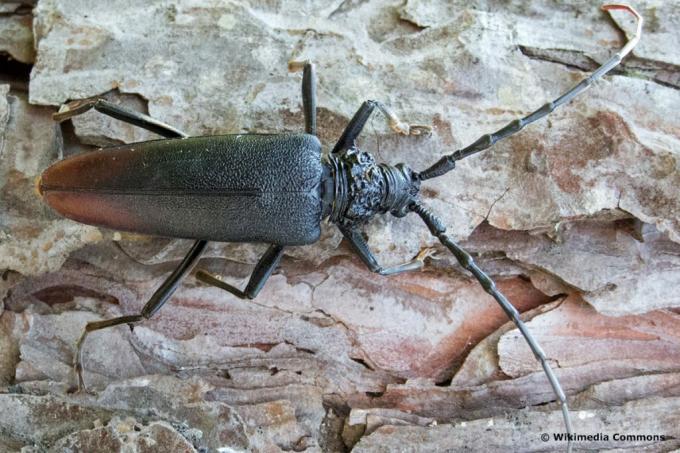
- also known as the billy goat, giant or billy goat
- one of the largest beetles in Central Europe
- reaches a body length of up to 5.5 cm
- Feelers sometimes longer than the body
- in males 10 cm long, in females up to 5 cm long
- Ely-coverts black, behind red-brown
- mainly colonizes old English oak and sessile oak
- Only oak stands without undergrowth are suitable as breeding trees
Tip: As a wood pest, the large oak buck was fought intensively for decades. Today it is one of the threatened species and is now strictly protected.
Lesser oak billy (Cerambyx scopolii)

- little brother of the Big Oak Goat
- also known as beech skewer
- Body length of 17-28 mm
- Elyra black, wrinkled, finely hairy
- Males have long antennae
- in the female about body length
- last antenna segment the longest
- occurs from May to July in deciduous forests, orchards and gardens
- Larvae develop in the wood
Tip: In the home garden you can spot them on elderberries, hawthorns, dogwoods, roses and umbellifers, for example.
Wood buck (Spondylis buprestoides)
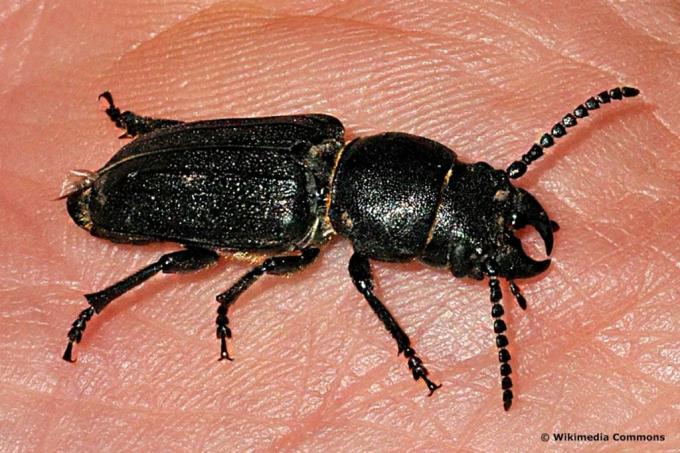
- typical inhabitant of pine forests
- rarely found in spruce forests
- nocturnal black beetle
- develops in stumps and trunks of conifers
- between 12 and 24 mm long
- black, cylindrical, stocky body
- short antennae, very strong upper jaw, strong forceps
- yellow hairline on the front and back of the chest
Tip: The wood buck is a black beetle with a lifespan of around three weeks, while the pupa and larval stage lasts two to three years.
Kurzflügler (Staphylinidae)
Imperial short-winged (Staphylinus caesareus)
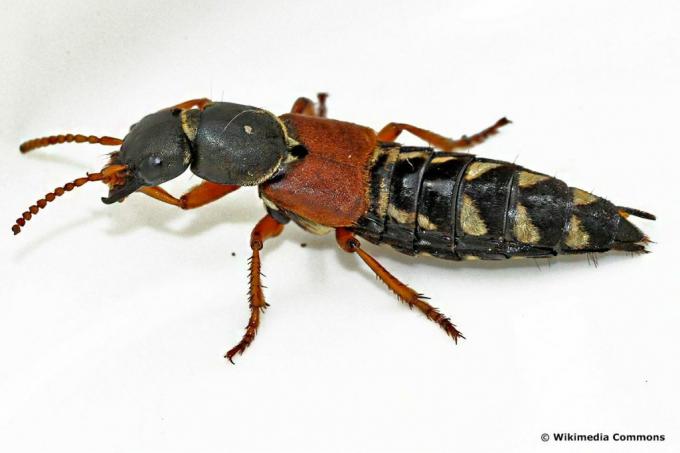
- becomes up to 25 mm long, airworthy, native
- Head, thorax and abdomen colored black
- Ears-coverts red-brown, not rigid
- cover only a third of the abdomen
- give the beetle unusual mobility
- antennae and legs are also red-brown
- On the neck, hem with yellow hair
- behavior similar to that of the black mold beetle in case of danger
- occurs from May to August
- feeds on slugs, insect larvae and worms
Tip: The imperial rush-winged beetle behaves similarly to the black mold beetle when in danger. He also takes a defensive position and uses his defensive glands on the abdomen.
Black mold beetle (Ocypus olens)
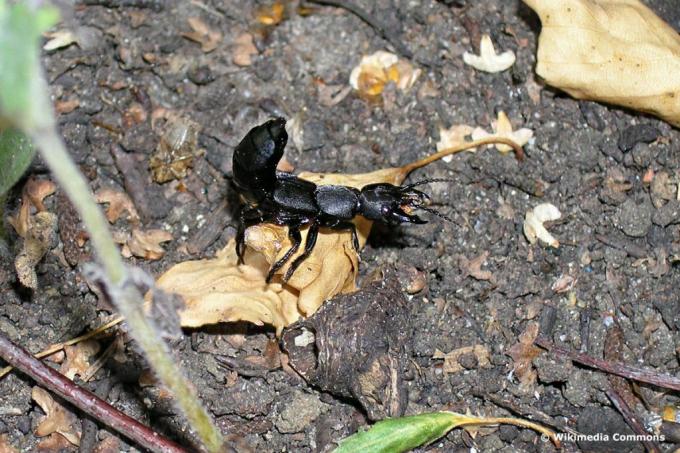
- the largest short-winged aircraft in Central Europe
- Body length from 22 to 23 mm
- deep black, matt, dense, dotted structure, black hair
- Abdomen less clearly punctured, more shiny than dull
- Elytres and pronotum about the same length
- black beetle with an oversized head, very well developed jaw-claws
- very defensive, raises the end of his abdomen in danger
- opens his pincers as a threatening gesture
- white defensive glands on the abdomen
- can hurl a foul-smelling, caustic secretion from it
- also not completely harmless for humans
- Not poisonous, but very painful
Tip: This beetle not only resembles a scorpion visually, but also in its behavior when threatened. Incidentally, the name 'mold beetle' refers to its preferred food, which consists of carrion and small invertebrates such as worms and woodlice.
Ground beetle (Carabidae)
Common shovel runner (Cychrus caraboides)
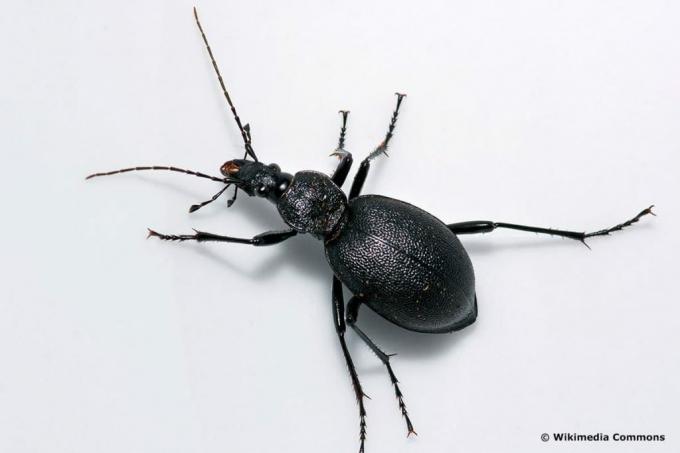
- nocturnal, completely black beetle, native
- with a body length of 12 to 20 mm
- less shiny than the narrow blade runner
- The most striking feature is the elongated head
- Toothed mouthparts stretched far forward
- lives in alder quarries and moist coniferous forests
- to be found under stones, moss, bark and dead wood
- overwinters as a larva and adult animal
Tip: This ground beetle feeds on Snails, especially shell snails, its saliva has a paralyzing effect on the snails. Where ground beetles hunt, you can often find broken snail shells.
Leather beetle (Carabus coriaceus)
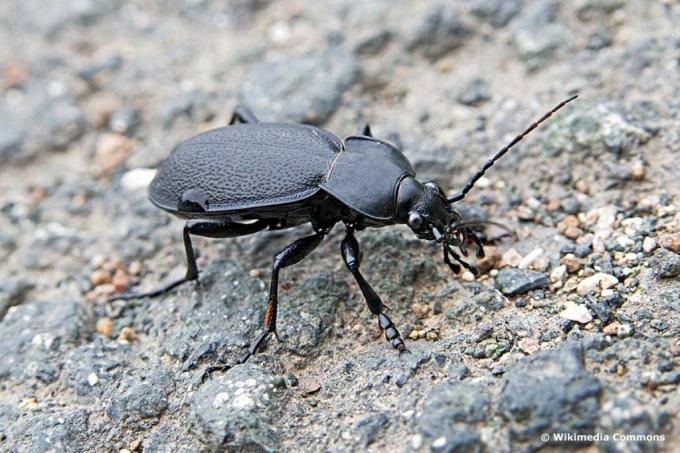
- largest domestic ground beetle
- crepuscular and nocturnal
- about 30 to 40 mm in size, unable to fly
- Upper side of the body black, matt to slightly shiny
- The underside as well as the head and legs are glossy black
- Elytres arched to strongly rounded, wrinkled
- Head and pronotum wrinkled more finely
- Splints of the middle legs with rust-red hair on the outside
- requires a certain amount of soil moisture
- therefore avoid dry places
- shows up approximately from April to October
- eats snails, worms, insects and carrion
Schröter (Lucanidae)
Beam shredder (Dorcus parallelipipedus)

- diurnal and nocturnal black beetle
- flat, matt black, 20 to 30 mm long
- Head of the male slightly punctured
- wider than that of the female
- also pronotum and wrinkled wing-cover slightly dotted, shiny
- strong upper jaw (forceps)
- Ten-link antennae
- belongs to the species that occur from May to August
- in biotopes rich in dead wood such as deciduous forests and old orchards
Stag beetle (Lucanus cervus)

- largest Central European beetle species
- unmistakable black beetle, easy to recognize
- Males 3.5 to 8 mm in size, females 3.0 to 4.5 mm
- black-brown basic color, wing brown-red
- Males have showy 'antlers'
- Upper jaw (mandibles) massively enlarged
- can make up almost half the length of the body
- Mouth parts shimmer red-brown to reddish
- Females have a narrower head and normally developed upper jaw
Stutz beetle (Histeridae)
Flattened stutz beetle (Hololepta plana)

- shiny black, strongly flattened body
- about eight to nine millimeters long
- Head retracted, cannot be withdrawn
- Throat plate that protects the mouthparts is missing
- long sickle-shaped upper jaw
- Stutz beetle lives predatory
- under loose bark of deciduous trees, especially poplars
- feeds on fly, mosquito and beetle larvae
- occurs from April to October
frequently asked Questions
Both the beetles and their larvae are equipped with a stable chitin shell. In adult animals, the chitin is strengthened by so-called stored sclerotin (structural proteins), which is supposed to cause the dark color. As a rule, newly hatched beetles are not yet fully colored. However, their final color develops after several hours.
In general, the diet of black beetles can be recognized by their mouthparts (mandibles). They are the most important tool for obtaining food. Herbivores among these beetles use them to cut parts from plants. The predators among them need them to pack their prey. But there are also exceptions, e.g. B. the male stag beetle, its mandibles are unsuitable as feeding tools and serve much more as weapons to fight against rivals.
The larvae can be recognized by their long, heavily chitinous body with a round cross-section. They are yellowish-brown in color and, like the adults, have powerful mouthparts.
